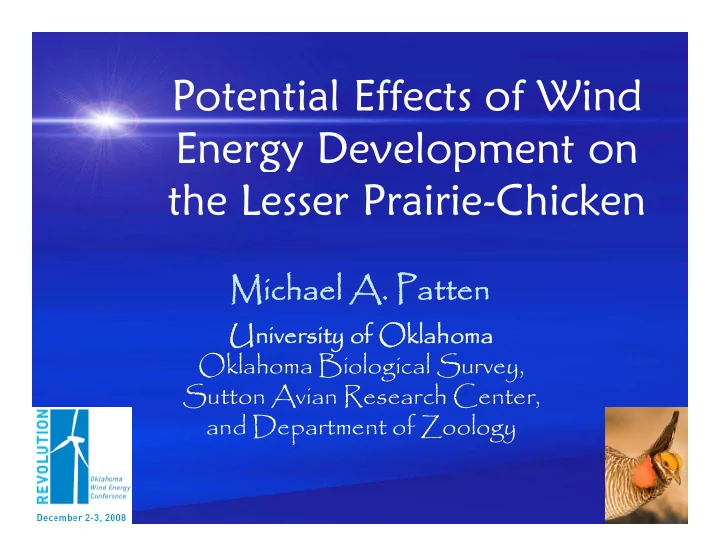

Potential Effects of Wind Potential Effects of Wind Energy Development on the Lesser Prairie-Chicken Michael A. Patten Michael A. Patten University of Oklahoma University of Oklahoma Oklahoma Biological Survey, Sutton Avian Research Center, h and Department of Zoology
The Lesser Prairie-Chicken The Lesser Prairie Chicken � � � � � � � � � � � � � � � � � � � �� � � � � � �
Vital Statistics Vital Statistics • endemic to shortgrass g prairie of the south-central United States • lek mating system: males l k l gather at communal displays to attract females • total world population numbers 10,000–20,000 • population has declined by >90% in the past century
Wind Farms Wind Farms
Highways and Power Lines Highways and Power Lines
Trapping and Tracking Trapping and Tracking
Avoidance of Power Lines Avoidance of Power Lines �� � � � � � � � � � � � � � � ���� � � � � � � � � � � � � � � �� � � � � � � � � � � � � � � � � � � � �
Avoidance of Highways Avoidance of Highways �� � � � � � � � � � � � � � � ���� � � � � � � � � � � � � � � �� � � � � � � � � � � � � � � � � � � � �
Power Lines Power Lines �� � � � � � � � � � � � � � � ���� � � � � � � � � � � � � � � �� � � � � � � � � � � � � � � � � � � � �
Avoidance Avoidance < 100 m < 100 m 100–500 m 100–500 m Lesser Prairie-Ch Lesser Prairie-Chicken icken transmission line 6 (88–129) 156 156 (398–471) Highway 412 24 24 (25–48) 182 (125–165) H h Highway 283 20 20 (135–181) ( ) 166 66 66 ( 66 (586–674) 6 6 ) Greater Prairie-Chicken Greater Prairie-Ch icken t transmission line i i li 0 (16–35) 0 (16 35) 5 (83 121) 5 (83–121) no evidence of avoidance > 500 m from any feature �� � � � � � � � � � � � � � � ���� � � � � � � � � � � � � � � �� � � � � � � � � � � � � � � � � � � � �
Avoidance (nests) Avoidance (nests) center-pivot improved road unimproved road building wellhead wellhead transmission line tranmission line 0 500 1000 1500 2000 meters � � � � � � � � �� � � � �� � � � � � � � � � � � ��� � � � � � � � � � � � � � � � � � � � � � � � � � � � � �� � � � �� ��� � � � ��� � ���
Avoidance – another look Avoidance another look transmission line b ildi building roads (any type) improved road improved road unimproved road center pivot irrigator center-pivot irrigator nests birds oil or gas wellhead 0 0 200 200 400 400 600 600 800 800 1000 1000 1200 1200 1400 1400 meters (±SE) � � � � � � � � �� �� � � � � � � � � � � � � � ���� � �� � � � � � � � � � �� � � � � � � � � � � � � � � � � � � � � � � �� � � � � � � � � � � � � � � � � � � � ��� �� � � � �� ���
Fence Collisions Fence Collisions New Mexico New Mexico females males collision raptor raptor mammal Oklahoma Oklahoma females males � � � � � � � � � � � � � � � ��� � � � � � � � � � � � �� � � � � � � � � � � � � � � �� �� ���
Conclusions Conclusions • prairie-chickens avoid tall structures (power lines) • prairie-chickens avoid busy roads • prairie-chickens avoid buildings p g • avoidance tends to be on the order of 500 m • Lesser Prairie Chickens tend not to nest near • Lesser Prairie-Chickens tend not to nest near anthropogenic features • Lesser Prairie-Chickens are prone to collide with Lesser Prairie Chickens are prone to collide with fences • a combination of roads, tall structures, and fences will further diminish already low populations
Potential Impacts Potential Impacts �� � � � � � � � � � � � � � � ���� � �� � � � � � � � � � � � �� � � � � � � � � � �
A Final Thought A Final Thought The Lesser Prairie-Chicken has The Lesser Prairie Chicken has never been found anywhere but in the United States. . . . United States. . . . If the species disappears, if we lose it forever, then we have no one to blame f h h bl but ourselves. Only foresight and wise stewardship will ensure that the species is safe. will ensure that the species is safe.
Thank You Thank You � � � � � � � � � � � � � � � � � � �� � � � � � �
Recommend
More recommend